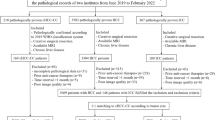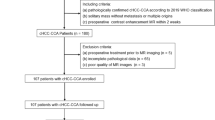Abstract
Objectives
To determine how MRI features are correlated to biomarkers, and to the prognostic factors for recurrence-free survival (RFS) and overall survival (OS) in combined hepatocellular carcinoma-cholangiocarcinoma (cHCC-CCA) patients.
Methods
The study enrolled 160 cHCC-CCA patients pathologically confirmed according to the 2019 WHO classification. The preoperative MRI features and clinical data were retrospectively evaluated and compared between patients grouped by AFP or CA19-9 level and with pathological findings. The RFS and OS of cHCC-CCA patients were estimated using Kaplan-Meier survival curves and compared using the log-rank test. Moreover, predictors of RFS and OS were investigated using Cox regression analyses.
Results
One hundred and sixty patients (mean age, males vs. females: 55.7 ± 10.2 years vs. 54.9 ± 14.0 years) were evaluated. The incidence of nodule-in-nodule architecture, mosaic architecture, intratumoral hemorrhage, hepatic capsule retraction, arterial phase peritumoral enhancement, and portal vein thrombus was significantly higher in patients with AFP > 20 ng/ml (all p < 0.05). Multivariate Cox regression analysis indicated that age (HR 1.031, p = 0.03), CA19-9 > 37 U/ml (HR 1.880, p = 0.04), arterial phase peritumoral enhancement (HR 2.287, p = 0.01), and delayed enhancement (HR 0.377, p = 0.02) were independent predictors of poor RFS, while arterial phase peripheral enhancement (HR 2.391, p = 0.04) was an independent predictor of poor OS.
Conclusions
cHCC-CCA imaging features are complex and not correlated with AFP or CA19-9. Age, CA19-9 > 37 U/ml, arterial phase peritumoral enhancement, and delayed enhancement are independent predictors of poor RFS. Arterial phase peripheral enhancement is an independent predictor of poor OS.
Key Points
• The imaging features of combined hepatocellular carcinoma-cholangiocarcinoma are complex and are not correlated with the alpha fetoprotein or CA19-9 levels.
• Age, CA19-9 > 37 U/ml, arterial phase peritumoral enhancement, and delayed enhancement are independent predictors of poor recurrence-free survival in combined hepatocellular carcinoma-cholangiocarcinoma patients.
• Arterial phase peripheral enhancement is an independent predictor of poor overall survival in patients with combined hepatocellular carcinoma-cholangiocarcinoma.






Similar content being viewed by others
Abbreviations
- AFP:
-
Alpha fetoprotein
- CA19-9:
-
Carbohydrate antigen 19-9
- cHCC-CCA:
-
Combined hepatocellular carcinoma-cholangiocarcinoma
- MVI:
-
Microvascular invasion
- OS:
-
Overall survival
- RFS:
-
Recurrence-free survival
References
Garancini M, Goffredo P, Pagni F et al (2014) Combined hepatocellular-cholangiocarcinoma: a population-level analysis of an uncommon primary liver tumor. Liver Transpl 20:952–959
Chu KJ, Lu CD, Dong H, Fu XH, Zhang HW, Yao XP (2014) Hepatitis B virus related combined hepatocellular-cholangiocarcinoma: clinicopathological and prognostic analysis of 390 cases. Eur J Gastroenterol Hepatol 26:192–199
Sempoux C, Kakar S, Kondo F, Schirmacher P (2019) Combined hepatocellular-cholangiocarcinoma. In: Bosman FT, Carneiro F, Hruban RH, Theise ND (eds) WHO classification of tumours: digestive system tumours, vol 2019, 5th edn. IARC, Lyon, pp 260–262
Shetty AS, Fowler KJ, Brunt EM, Agarwal S, Narra VR, Menias CO (2014) Combined hepatocellular-cholangiocarcinoma: what the radiologist needs to know about biphenotypic liver carcinoma. Abdom Imaging 39:310–322
Gera S, Ettel M, Acosta-Gonzalez G, Xu R (2017) Clinical features, histology, and histogenesis of combined hepatocellular-cholangiocarcinoma. World J Hepatol 9:300–309
Yin X, Zhang BH, Qiu SJ et al (2012) Combined hepatocellular carcinoma and cholangiocarcinoma: clinical features, treatment modalities, and prognosis. Ann Surg Oncol 19:2869–2876
Jeon SK, Joo I, Lee DH et al (2019) Combined hepatocellular cholangiocarcinoma: LI-RADS v2017 categorisation for differential diagnosis and prognostication on gadoxetic acid-enhanced MR imaging. Eur Radiol 29:373–382
Parpart ST, Roessler S, Dong F et al (2014) Modulation of miR-29 expression by alpha-fetoprotein is linked to the hepatocellular carcinoma epigenome. Cancer Res. https://doi.org/10.1158/1538-7445.AM2014-5183
Bergquist JR, Ivanics T, Storlie CB et al (2016) Implications of CA19-9 elevation for survival, staging, and treatment sequencing in intrahepatic cholangiocarcinoma: a national cohort analysis. J Surg Oncol 114:475–482
Kudo A, Matsumura S, Ban D et al (2014) Does the preoperative alpha-fetoprotein predict the recurrence and mortality after hepatectomy for hepatocellular carcinoma without macrovascular invasion in patients with normal liver function? Hepatol Res 44:E437–E446
Huang XT, Huang CS, Li JH, Cai JP, Chen W, Yin XY (2018) Prognostic significance of neutrophil/prealbumin ratio for intrahepatic cholangiocarcinoma undergoing curative resection. HPB (Oxford) 20:1215–1222
Jiang XX, Huang XT, Huang CS, Chen LH, Liang LJ, Yin XY (2020) Long-term outcome and prognostic factors of combined hepatocellular carcinoma and cholangiocarcinoma after curative resection. Gastroenterol Rep 8:134–142
Wang XL, Wang WT, Ma XJ et al (2020) Combined hepatocellular-cholangiocarcinoma: which preoperative clinical data and conventional MRI characteristics have value for the prediction of microvascular invasion and clinical significance? Eur Radiol 30:5337–5347
Ma XJ, Liu LH, Fang J et al (2020) MRI features predict microvascular invasion in intrahepatic cholangiocarcinoma. Cancer Imaging. https://doi.org/10.1186/s40644-020-00318-x
Luy SC, Li LX, Zhao X, Ren ZY, Cao D, He Q (2020) Prognostic impact of lymph node parameters in distal cholangiocarcinoma after pancreaticoduodenectomy. World J Surg Oncol. https://doi.org/10.1186/s12957-020-02040-1
Joo I, Kim H, Lee JM (2015) Cancer stem cells in primary liver cancers: pathological concepts and imaging findings. Korean J Radiol 16:50–68
Jung DH, Hwang S, Song GW et al (2017) Longterm prognosis of combined hepatocellular carcinoma-cholangiocarcinoma following liver transplantation and resection. Liver Transpl 23:330–341
He C, Mao Y, Wang J et al (2018) The predictive value of staging systems and inflammation scores for patients with combined hepatocellular cholangiocarcinoma after surgical resection: a retrospective study. J Gastrointest Surg 22:1239–1250
Choi JY, Lee JM, Sirlin CB (2014) CT and MR imaging diagnosis and staging of hepatocellular carcinoma: part II. Extracellular agents, hepatobiliary agents, and ancillary imaging features. Radiology 273:30–50
Lacomis JM, Baron RL, Oliver JH, Nalesnik MA, Federle MP (1997) Cholangiocarcinoma: delayed CT contrast enhancement patterns. Radiology 203:98–104
Asayama Y, Yoshimitsu K, Irie H et al (2006) Delayed-phase dynamic CT enhancement as a prognostic factor for mass-forming intrahepatic cholangiocarcinoma. Radiology 238:150–155
Park SH, Lee SS, Yu E et al (2017) Combined hepatocellular-cholangiocarcinoma: gadoxetic acid-enhanced MRI findings correlated with pathologic features and prognosis. J Magn Reson Imaging 46:267–280
Nash GF, Turner LF, Scully MF, Kakkar AK (2002) Platelets and cancer. Lancet Oncol 3:425–430
Hu K, Wang ZM, Li JN, Zhang S, Xiao ZF, Tao YM (2018) CLEC1B expression and PD-L1 expression predict clinical outcome in hepatocellular carcinoma with tumor hemorrhage. Transl Oncol 11:552–558
Kim TH, Kim H, Joo I, Lee JM (2020) Combined hepatocellular- cholangiocarcinoma: changes in the 2019 World Health Organization Histological Classification System and Potential Impact on Imaging-Based Diagnosis. Korean J Radiol 21:1115–1125
Elsayes KM, Hooker JC, Agrons MM et al (2017) 2017 version of LI-RADS for CT and MR imaging: an update. Radiographics 37:1994–2017
Potretzke TA, Tan BR, Doyle MB, Brunt EM, Heiken JP, Fowler KJ (2016) Imaging features of biphenotypic primary liver carcinoma (hepatocholangiocarcinoma) and the potential to mimic hepatocellular carcinoma: LI-RADS analysis of CT and MRI features in 61 cases. AJR Am J Roentgenol 207:25–31
Lee HS, Kim MJ, An C (2019) How to utilize LR-M features of the LI-RADS to improve the diagnosis of combined hepatocellular-cholangiocarcinoma on gadoxetate-enhanced MRI? Eur Radiol 29:2408–2416
Chernyak V, Fowler KJ, Kamaya A et al (2018) Liver Imaging Reporting and Data System (LI-RADS) version 2018: imaging of hepatocellular carcinoma in at-risk patients. Radiology 289:816–830
Funding
This study has received funding by National Natural Science Foundation of China (grant number 91859107), Shanghai Science and Technology Committee (grant number 18DZ1930102),Shanghai Science and Technology Committee (grant number 19411965500), Zhongshan Hospital, Fudan University (grant number 2018ZSLC22), Shanghai Municipal Key Clinical Specialty (grant number W2019-018), Clinical Research Plan of SHDC (grant number SHDC2020CR1029B), and Zhongshan Hospital, Fudan University (grant number 2020ZSLC61).
Author information
Authors and Affiliations
Corresponding authors
Ethics declarations
Guarantor
The scientific guarantor of this publication is Mengsu Zeng.
Conflict of interest
The authors of this manuscript declare no relationships with any companies, whose products or services may be related to the subject matter of the article.
Statistics and biometry:
Two of the authors (Changwu Zhou and Li Ma) have significant statistical expertise.
Informed consent
Written informed consent was obtained from all patients in this study.
Ethical approval
Institutional Review Board approval was obtained.
Study subjects or cohorts overlap
Some study subjects or cohorts have been previously reported in a prior study entitled “Combined hepatocellular-cholangiocarcinoma: which preoperative clinical data and conventional MRI characteristics have value for the prediction of microvascular invasion and clinical significance?” on a publication of European Radiology.
Methodology
• retrospective
• observational
• performed at one institution
Additional information
Publisher’s note
Springer Nature remains neutral with regard to jurisdictional claims in published maps and institutional affiliations.
Rights and permissions
About this article
Cite this article
Zhou, C., Wang, Y., Ma, L. et al. Combined hepatocellular carcinoma-cholangiocarcinoma: MRI features correlated with tumor biomarkers and prognosis. Eur Radiol 32, 78–88 (2022). https://doi.org/10.1007/s00330-021-08188-y
Received:
Revised:
Accepted:
Published:
Issue Date:
DOI: https://doi.org/10.1007/s00330-021-08188-y




